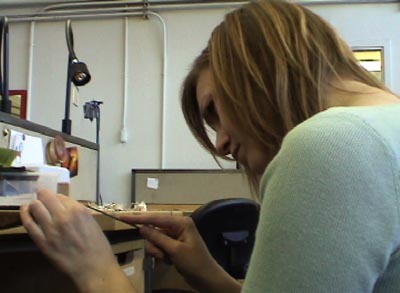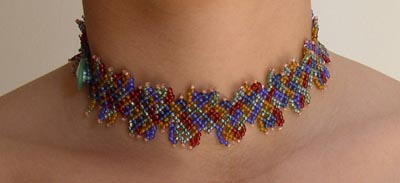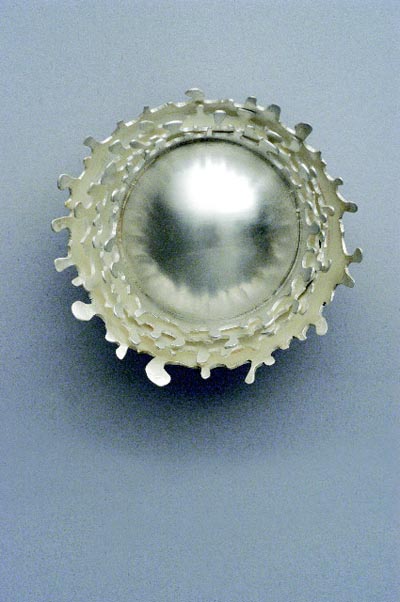
Sports
- The Outdoor Program helps people plan adventures.
- Adam Lake uses fencing to bring people together.
- Win or lose, the Pit Crew keeps Mac Court shaking for the Ducks.
- Tearing at jerseys and slamming into each other. It's women's rugby.
Changes
- A Taiwanese student finds adjusting to a foreign culture challenging.
- A close-up look at the ASUO president.
- A senior's abrupt transition to Eugene after Hurricane Katrina.
Arts
- A ballroom dance club president wears many hats and makes them too.
- Whether composing or jamming on his mandolin, Jesse Jones shares his love of music.
- Non-traditional African dance brings a new sense of community.
- The Student Fibers Guild proves that knitting isn't just for old ladies anymore.
- Halo Jones' music and art expresses his dark and light sides.
- A musician, student, activist and artist.
- For Ashley Maury, jewelry is more than decorative.
- A student TV show features news, sports, drama and comedy.
- A printmaking student goes beyond the studio and into the city.

For Ashley Maury, jewelry is more than decorative.
By Emily Charrier
| See the progression of a piece of jewelry |
She leans over the small piece of silver, file in hand as she tries to perfect the raindrop shape.
Her hands move quickly, filing the sharp edges, forcing flecks of silver to fly into the air. After several minutes the hard lines have become a smooth, rounded shape.

Jewelry major Ashley Maury files a piece of silver. |
“I spend a lot of time making tedious things,” Maury said half-seriously. “I like making jewelry because people are going to wear it… and it’s really personal. Knowing someone is going to take something you made and show it as a part of themselves and wear it around so everyone knows it’s a part of them is really interesting to me.”
Maury was born and raised in Alaska, spending her winters in Anchorage and her summers in the tiny artist community of Halibut Cove, on the southern peninsula of Alaska. The town has a population of 20 in the winter and around 100 in the summer. The island is home to one restaurant and two art galleries that support the 16 local artists. Maury’s mother worked in the gallery, allowing Maury to spend her days surrounded by art. From a young age she was intrigued by jewelry.

Halibut Cove, Alaska. |
“I found myself spending a lot of time in the gallery and I would be drawn to the jewelry cases always,” she said, emphasizing the word always.
An artistic streak runs through Maury’s family; both of her parents are potters. She grew up with a ceramic studio in the room under her bedroom, but she was never drawn to work with clay.
“Ceramics are so soft,” she said with a laugh. “It’s a mater of material. I just like working with metal because it’s rigid.”
Although she resisted joining the family business, her interest in jewelry stuck. She began spending time with a local artist who made jewelry.
“I worked for her in the summer when I was 16 cutting animal shapes out of metal for earrings. [It was] just really tedious, and I was being paid next to nothing,” she said. “But when I started making jewelry in classes I realized that skill was just so great to have.”
While that experience began her work with metal, she had already been making jewelry for years. Maury began beading jewelry before she can remember. At age 17, she took a series of classes on bead weaving and learned a variety of techniques.

Maury's intricate beadwork. |
After that summer she knew she had found her career. Maury began her senior year of high school and faced the daunting task of picking a college. She simplified the process by having just two criteria. The school had to have a jewelry program and it had to be on the West Coast. After touring all the schools that fit her criteria, she chose the University of Oregon, and her metal jewelry work began.
Before she was able to work with silver, she had to take basic art and drawing classes, which help her sketch her designs. Soon she was working with her preferred material, metal. She found herself in an expensive major, which required such materials as sheets, tubes and wires of silver. She spends about $100 a term on materials necessary for her classes. When designing her pieces, Maury said, she always finds inspiration in nature. She has created a series of pieces based on one storm.

An example of her raindrop-inspired series. This piece is a silver brooch. |
“I’d seen rain dropping on pavement, and it was splashing and bubbling. It was one of those driving rains where it was just pouring down. So I have this splash design I keep repeating in my work,” she said.
Like all artists, she finds that a mental block sometimes sets in, and she can’t think of anything to create. When this happens, she finds inspiration from the work of others by visiting metalcyberspace.com, a website consisting of links to hundreds of international jewelry galleries. Browsing through the galleries of other metal artists always revives her imaginative spirit, and she is again ready to create. Most of Maury’s pieces are metal, typically silver or copper. However, she also spent time working with gemstones in the Deep South.
Maury left the U of O and spent one term at the Savannah College of Art and Design, which offers a more intensive jewelry program. There she learned about lapidary, the cutting and polishing of gemstones.
“It’s really scary! You use a huge diamond saw blade at least eight inches across,” she said. “They’re pretty big machines that could really hurt you.”
The diamond blade cuts big stones into smaller ones, and then diamond sandpaper is used to polish the stones. While she’s glad she learned about the process, she said for the time being she’ll stick to purchasing the stones she uses.
“I’m not really into the lapidary side of it,” she said. “In my work, I am more interested in how metal works.”
After her brief time in Georgia, Maury returned to finish her education at the U of O. When she graduates in June 2006, she will return to Alaska, where she has been named partner of the gallery where she first sold her work. She hopes to one day take over the gallery and expand it to the Internet. She also plans to set up a metalsmith's studio so she can continue making jewelry. With purchasing tools and materials, it will not be a cheap undertaking.
“My sister and brother both got laptops for graduation,” she said. “I’m asking for jewelry tools.”